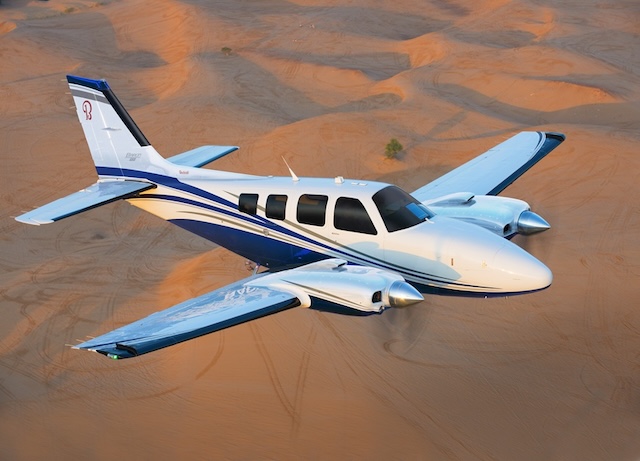Beechcraft Baron
Summary
| Category | Military Training Aircraft |
| Origin country | 🇺🇸 United States |
| Manufacturer | Beechcraft |
| First flight | 29 February 1960 |
| Year introduced | 1961 |
| Number produced | 6884 units |
| Average unit price | $1 million |
Description
The Model 90 King Air was initially conceived as the Model 120 in 1961, originally intended to be powered by two Turbomeca Bastan VI engines. Beechcraft began test flights of the proof-of-concept Model 87, a modified Queen Air, on May 15, 1963, utilizing Pratt & Whitney Canada PT6A-6 engines. A new type was announced in July, and orders began a month later for the "King Air," slated for deliveries in Autumn 1964. The first definitive prototype, designated Model 65-90 and fitted with PT6A-6 engines, first flew on January 24, 1964. Following ten months of testing, the Model 87 was delivered to the United States Army as the NU-8F in 1964. The first production aircraft was delivered on October 8, with 152 aircraft ordered by the end of the month; seven were built by year's end. The King Air was produced continuously from 1964 to 2021.
The King Air line is characterized by a number of twin-turboprop models divided into two families: the Model 90 and 100 series, and the later T-tail Model 200 and 300 series. The Model 90 King Air was originally conceived as the Model 120 in 1961 and designated Model 65-90. Military versions built included the 65-A90-1, 65-A90-2, 65-A90-3, and 65-A90-4, all being unpressurised models based on the Model 87. The Model C90 featured increased wingspan, MTOW, and PT6A-20A engines, while the Model F90 featured the T-tail of the Model 200 mated to the fuselage and wings of the E90, with PT6A-135 engines. The Model C90GT was fitted with PT6A-135As, increasing performance with a higher cruise speed and climb rate, while the C90GTi featured the Rockwell Collins Proline 21 avionics package. The Model 100 is a stretched derivative of the Model 90, while the B100 featured Garrett AiResearch TPE-331 engines. A number of aftermarket modifications and upgrades are available for 90 and 100 Series King Airs, including engine upgrades and airframe modifications.
The King Air, particularly the Model 90 series, has seen military service across the globe. The United States military utilized King Air 90s in diverse roles, including VIP and liaison transport, with designations such as VC-6A, T-44 Pegasus, and U-21 Ute. The U-21 Ute, a common variant used by the US Army, consisted mainly of unpressurized Model 87 derivatives. Some U-21 variants were equipped for electronic battlefield surveillance. During the Lyndon Johnson administration, a B90 King Air, designated VC-6A, served as Air Force One for presidential transport between Bergstrom Air Force Base and the Johnson family ranch. Japan's Maritime Self-Defense Force operates 40 C90 and C90A King Airs, designated as TC-90 trainers, LC-90 transports, and a UC-90 aerial survey aircraft. The JMSDF has also transferred TC-90 aircraft to the Philippines for maritime patrols, along with providing pilot and maintenance training.
Main Variants:
-
Model 65-90: The original King Air variant, it was based on the Model 88 and featured two PT6A-6 turboprop engines and a 9,000 lb Take Off Gross Weight.
-
Model 65-A90: An upgraded Model 90, it featured a higher TOGW, more powerful engines, a redesigned flightdeck, and a new engine de-ice system.
-
Model B90: This variant, based on the A90, featured an increased TOGW, improved ailerons, an extended wingspan, enhanced instrumentation and pressurization, and an additional side window.
-
Model C90: Based on the B90, this version incorporated the Model 100's cabin environment and pressurization system, along with more powerful engines.
-
Model C90GT: This updated variant featured more powerful engines flat rated to the same output as earlier models, providing better climb and cruise performance.
Technical specifications
| Version: B55 Baron | |
|---|---|
| Wing area | 18.5 m² (199.2 sqft) |
| Wingspan | 11.3 m (37.1 ft) |
| Height | 3.0 m (9.7 ft) |
| Length | 9 m (29.5 ft) |
| Service ceiling | 6,005 m (19,701 ft) |
| Empty weight | 1,432 kg (3,157 lbs) |
| Max. takeoff weight | 2,313 kg (5,099 lbs) |
| Climb rate | 8.5 m/s (27.9 ft/s) |
| Powerplant | 2 x pistons engine Continental IO-470L delivering 194 kW each |
Current operating countries
| Country | Units | ||
|---|---|---|---|

|
Turkey | 5 | |

|
Indonesia | 2 | |

|
Mexico | 2 | |

|
Paraguay | 2 | |

|
Uruguay | 2 | |

|
Argentina | 1 | |

|
Dominican Republic | 1 | |

|
Panama | 1 | |

|
Peru | 1 | |

|
United States | 1 | |
All operators
